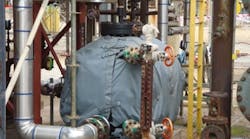Sponsored Recommendations
Sponsored Recommendations
A site-wide steam and condensate system audit of a Midwest refinery conducted by Armstrong and its local representative, the Steam Economies Company, revealed that the refinery was discharging condensate to the sewer through a temporary hose due to a faulty condensate pumping system.
As it investigated the situation further, the audit team discovered the system that returned condensate to the boiler house used electrically driven centrifugal pumps. While these units worked most of the time, they required significant maintenance due to their numerous parts and sensitive sensors that demanded ongoing calibrations. Because the pumps were old, they also were unreliable and parts were hard to find. Moreover, the system needed a pump-around loop to prevent burnout of the pump and motor. Also, the controls to direct the condensate were complicated and required periodic maintenance.
Any replacement electrical pump would have to meet all the electrical safety requirements of a Class 1 Division 1 environment and its installation cost would be high. Other drawbacks of an electrical pump in condensate service are cavitation issues due to insufficient net positive suction head (NPSH) and leaking pump seals.
Seeking a lower cost and a more dependable solution, the refinery was drawn to the simplicity of Armstrong's PT-516 pump (Figure 1). It uses steam from the plant rather than electrical power. And, unlike the centrifugal pumps that ran continuously, the PT-516 only consumes steam when the condensate level in the pump requires a pumping cycle. The refinery reports there no longer are any NPSH concerns and hotter condensate (212°F versus 180°F) now can be returned. The steam-driven pump can handle up to 65,000 lb/hr of condensate.
The pump plus accessories and check valves cost about $20,000. Installation also involved removal of unneeded piping, controls and valves. The payback period should run two to three years.
The Armstrong PT-516 steam pump has been in service for more than a year with no interruptions to returning condensate from the crude unit to the boiler house. This has helped the refinery maximize energy savings and capture an additional $75,000 annually.
Now the refinery is investigating other opportunities to use steam-driven technology for condensate collection and return.
MICHAEL CALOGERO, P.E., is Allentown, Pa.-based refining and petrochemical manager for Armstrong International. E-mail him at [email protected].
